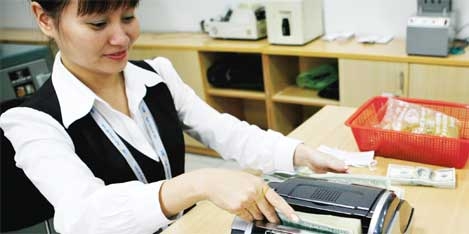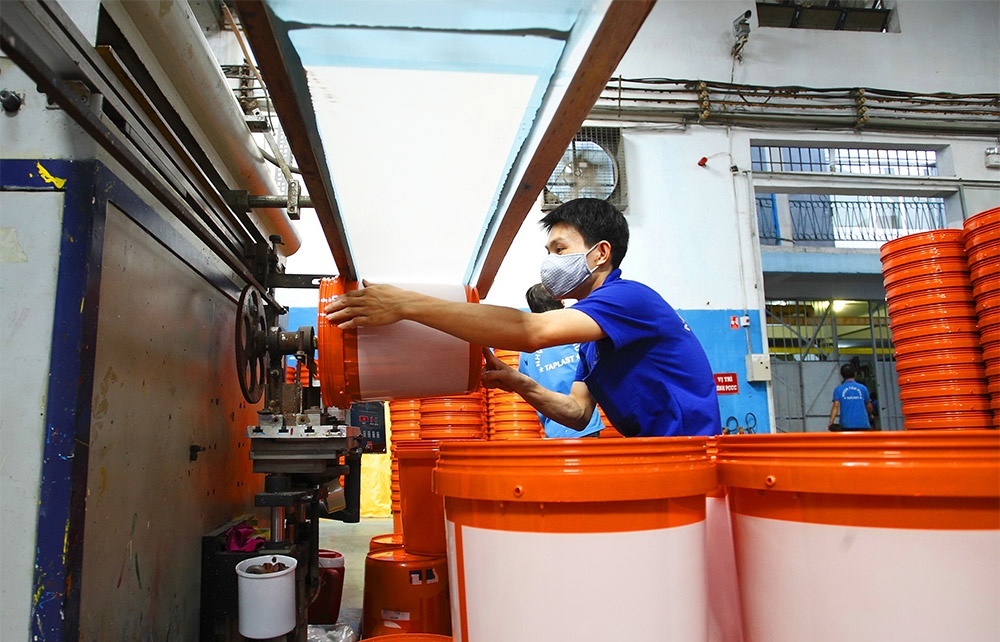Dong depreciation move
 |
| The market’s demand for US dollars is growing more acute |
Last week, the State Bank weakened the Vietnamese dong via the mid-point exchange rate by 2.1 per cent, to VND18,932 per dollar, from VND18,544, effective from August 18.
Thus, the new trading range for the dong now stands at VND18,364-VND19,500 per dollar. If spot rates continue to trade around current levels of VND19,100 like it was for the past months, then effectively there will be no depreciation.
Vo Thi Sanh, BIDV Treasury Department vice head, said that the forex market had started to show signs of drying up.
“In the first half of the year, local enterprises actively sold dollars to banks. Local banks then sold them back to the State Bank’s coffers. Now, local enterprises’ demands for greenbacks is climbing. The State Bank can open its coffers selling back to commercial banks or depreciating the currency. They picked the latter option,” said Sanh.
The country’s trade deficit has stabilised at $1 billion per month, with the shortfall during January-July being $7.4 billion. This was more than covered by structural inflows of $10.4 billion in the first half of 2010. Actual disbursed foreign direct investment was $6.4 billion and remittances were $4 billion.
“Thus, I think it is more a prevention of possible forex instability in the future rather than a measure to cure existing problem,” said Sanh.
Prakriti Sofat, regional economist at Barclays Capital, believed that the main reason for depreciating the currency was to balance foreign exchange supply and demand and at the margin support growth through exports.
“However, given on-shore concerns about roll-over risk from local dollar borrowing, spot rates can potentially move to the top end of the new trading band at VND19,500 per dollar. If this materialises, it would be an effective weakening of 2.1 per cent and in line with our expectation of USD/VND drifting towards 19,500 in the third quarter of 2010,” said Sofat.
In fact, by end of last week, the greenback was traded at top end of the band, VND19,500 per dollar.
At the moment, local banks are allowed to trade the greenback within 3 per cent either side of the State Bank’s interbank mid-point exchange rate.
It should be noted that the State Bank last depreciated the currency in February, 2010 also by weakening the mid-point by 3.4 per cent, to VND18,544 per dollar. However, given the pre-emptive nature of the weakening, spot rates stayed below the top end of the band of VND19,100 per dollar from February-June 2010.
Sofat added that with the year-on-year inflation momentum easing from 9.5 per cent in March to 8.2 per cent in July and the trade deficit having stabilised at roughly $1 billion per month, the State Bank’s bias had been to support growth since April, 2010.
“We believe the State Bank is allowing currency weakness to support exports, as the low-value-add products of the country typically compete on price in the global market. However, the weaker currency will likely add to imported price pressures - according to our estimates, a 1 per cent move in USD/VND exchange rate adds roughly 0.15 per cent to inflation” added Sofat.
Alan Pham, chief economist at VinaSecurities, said that 2 per cent depreciation was probably too small to impact on exports.
“However, this has an important signaling effect that the authority has taken concrete step to stabilise the USD/VND rate. After the depreciation of 3.4 per cent in February, local forex market was calm for five months. If history was to repeat itself, the dollar exchange rate would stay stable until the end of 2010,” Pham said.
What the stars mean:
★ Poor ★ ★ Promising ★★★ Good ★★★★ Very good ★★★★★ Exceptional
Latest News
More News
- Mandatory biometric verifications to be expanded (December 19, 2024 | 10:37)
- Bank transfers lead to rebranding phase (December 19, 2024 | 09:00)
- Ownership of financial groups comes to fore (December 18, 2024 | 11:34)
- AI will be a game-changer in banking and finance (December 18, 2024 | 10:00)
- F88 partners with MB to transform over 850 financial stores into bank offices (December 17, 2024 | 18:04)
- Obstacles to stock-market upgrade to be removed (December 17, 2024 | 11:29)
- Vietnam seizes opportunities amid global trade shifts (December 16, 2024 | 18:00)
- Long-term perspective remains optimal approach (December 16, 2024 | 14:26)
- Fiscal measures to be based on upcoming US status (December 16, 2024 | 10:09)
- PetroVietnam accelerates divestment from PVI (December 16, 2024 | 06:59)

















 Mobile Version
Mobile Version